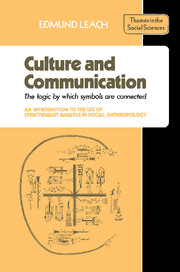 Culture and Communication
Culture and Communication Book contents
- Frontmatter
- Contents
- Culture and communication: the logic by which symbols are connected
- Introduction
- 1 Empiricists and rationalists: economic transactions and acts of communication
- 2 Problems of terminology
- 3 Objects, sense-images, concepts
- 4 Signals and indices
- 5 Transformations
- 6 Theories of magic and sorcery
- 7 The symbolic ordering of a man-made world: boundaries of social space and time
- 8 The material representation of abstract ideas: ritual condensation
- 9 Orchestral performance as a metaphor for ritual sequence
- 10 The physiological basis of sign/symbol sets
- 11 Mapping: time and space as reciprocal representations
- 12 Rank order and orientation
- 13 Examples of binary coding
- 14 Mating prescriptions and proscriptions
- 15 Logic and mytho-logic
- 16 Basic cosmology
- 17 Rites of transition (rites de passage)
- 18 The logic of sacrifice
- 19 Conclusion
- Bibliography
- Index
18 - The logic of sacrifice
Published online by Cambridge University Press: 05 June 2012
- Frontmatter
- Contents
- Culture and communication: the logic by which symbols are connected
- Introduction
- 1 Empiricists and rationalists: economic transactions and acts of communication
- 2 Problems of terminology
- 3 Objects, sense-images, concepts
- 4 Signals and indices
- 5 Transformations
- 6 Theories of magic and sorcery
- 7 The symbolic ordering of a man-made world: boundaries of social space and time
- 8 The material representation of abstract ideas: ritual condensation
- 9 Orchestral performance as a metaphor for ritual sequence
- 10 The physiological basis of sign/symbol sets
- 11 Mapping: time and space as reciprocal representations
- 12 Rank order and orientation
- 13 Examples of binary coding
- 14 Mating prescriptions and proscriptions
- 15 Logic and mytho-logic
- 16 Basic cosmology
- 17 Rites of transition (rites de passage)
- 18 The logic of sacrifice
- 19 Conclusion
- Bibliography
- Index
Summary
The argument of the last two sections has again become very abstract and you may well be asking yourself how such very general theory can have practical use. How could it help the anthropologist to understand what is going on when he or she encounters a totally unfamiliar chunk of culturally defined behaviour?
The present section applies the theory to the procedures of sacrifice. This seems an appropriate test case because, although animal sacrifice is a very common feature of religious ritual, most of my readers will have had no first-hand acquaintance with such performances. If we now examine the details of a description of a sacrifice, how far does the theory in fact help to elucidate what is going on?
The central puzzle about sacrifice centres around the metaphor of death. What has the killing of animals got to do with communication between Man and Deity or with changing the social status of individuals? My own immediate problem is of a different kind. How can I describe enough of the total context of a typical sacrificial rite for you to get some feeling of the complexity of the problems which face the anthropological analyst when he meets with such performances in the field? For you must understand that in any fieldwork situation many things are going on at once. At the very least, any ritual activity has visual, verbal, spatial and temporal dimensions; in addition, noise, smell, taste, touch may all be relevant. Many action sequences will probably be repeated several times over but often with slight variations at each repetition.
- Type
- Chapter
- Information
- Culture and CommunicationThe Logic by which Symbols Are Connected. An Introduction to the Use of Structuralist Analysis in Social Anthropology, pp. 81 - 94Publisher: Cambridge University PressPrint publication year: 1976
- 1
- Cited by


